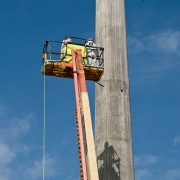Safety Tip of the Week: Basic Platform Safety
Force prides itself on its excellent safety and on providing the users of its access equipment with thorough training; however, accidents associated with elevated work platforms (EWPs) do still occur. To stay safe while you work on elevated platforms, here are a series of things to keep in mind when using access gear.
Preparing For Work
All Force’s Elevated Work Platform equipment for hire is regularly inspected and maintained to ensure it is in excellent working condition. However, once it is in use on site, operators must remain vigilant and be encouraged to report any concerns or problems.
EWPs should only ever be used on stable, level ground. For outdoor sites, this should be checked regularly, particularly in the event of inclement weather. High winds can affect the stability of your platform, causing it to tilt. Always be aware of safe wind speeds for your equipment and inspect any EWPs after strong winds, heavy rain or freezing conditions.
Irregular features such as trenches, manholes and compacted earth can all lead to overturning of platforms, so always be alert when operating near these features. Always chock and extend any outriggers before raising the platform. Check the manual to assess whether spreader plates are required. Guardrails and toe boards should be fitted and effective.
Check the dimensions and weight of any materials being used and consider how these materials will be handled and loaded. Additional lifting equipment may be needed to safely transport materials to and from the platform.
Confined Spaces
The most common cause of injury while using EWPs is the operator becoming trapped against structures either overhead or adjacent to the platform. Before operating any EWP, ensure that the operator has been made aware of any dangers and is familiar with the health and safety rules for the site. For very confined spaces, choose access equipment that has safety features built in, for example, covered control panels to prevent accidental operation. Bear in mind environmental hazards, for example overhead cables and passing traffic.
Anyone working long shifts in a confined space will know how tempting it is to place tools and equipment down to keep them handy. Unfortunately, in cramped spaces like baskets and work platforms, those handy items can quickly become trip hazards. Always keep the work platform free of obstructions to prevent tripping.
Falling is a potential hazard, and workers should have a restraining harness attached to an anchor point on the working platform. Items falling from the basket can prove as harmful to those passing underneath as falls can for those in the basket. In most cases, creating a barrier around the area underneath the platform is sufficient to protect other workers and passers-by from falling tools.
A lot of site health and safety guidance is codified common sense. Encourage workers to keep risks in mind and operate equipment mindfully. All operators of EWPs under 11 metres should have a yellow card certification of competency, which can be provided by Force’s in-house training team.



